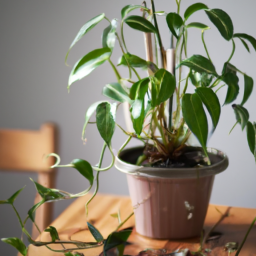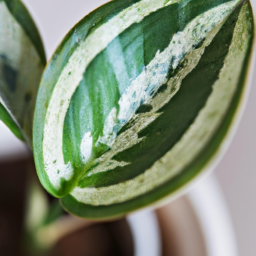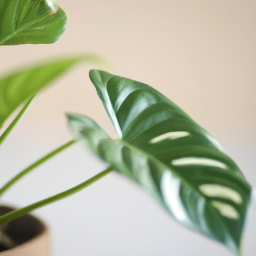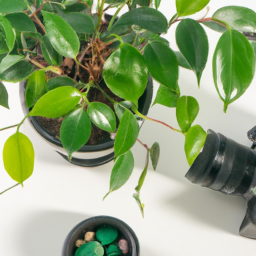
Have you ever wondered when houseplants became popular? It seems like everywhere you look these days, people are filling their homes with lush greenery and beautiful blooms. But when did this trend really take off? In this blog post, we’ll dive into the history of houseplants and explore how they became a staple in modern home decor. So grab a cup of tea, sit back, and let’s uncover the fascinating story of when houseplants became popular.
The History of Houseplants: When Did They Become Popular?
Houseplants have become an essential part of interior design and home decor in recent years, but their popularity actually dates back centuries. Let’s take a closer look at the fascinating history of houseplants and explore when they first became popular.
Ancient Origins of Houseplants
The use of houseplants for decorative purposes can be traced back to ancient civilizations such as the Egyptians, Greeks, and Romans. These cultures often incorporated plants into their homes to bring a sense of nature indoors and create a more pleasant living environment.
In ancient Egypt, for example, papyrus plants were commonly grown indoors for their aesthetic appeal and symbolic significance. The Greeks and Romans also valued houseplants for their beauty and believed that they had the power to purify the air and promote well-being.
Houseplants continued to be popular throughout the Middle Ages and Renaissance, with wealthy Europeans displaying exotic plants brought back from their travels to distant lands. These botanical treasures were often showcased in ornate conservatories and greenhouses, demonstrating the owner’s wealth and sophistication.
The Victorian Era and the Rise of Houseplant Culture
The Victorian era marked a significant turning point in the history of houseplants, as advances in horticulture and transportation made it easier to cultivate and transport exotic plant species. This period saw a surge in the popularity of houseplants among the middle and upper classes, who viewed them as status symbols and prized possessions.
Victorian homes were often filled with an array of houseplants, including ferns, palms, and orchids, which were displayed in elaborate plant stands and decorative pots. The Victorians also embraced the language of flowers, using plants to convey messages of love, friendship, and other sentiments.
Houseplant culture continued to flourish in the early 20th century, with the introduction of new plant varieties and growing techniques. The invention of the terrarium and the popularity of indoor gardening further fueled the craze for houseplants, making them more accessible to a wider audience.
Modern-Day Houseplant Craze
In recent years, houseplants have experienced a resurgence in popularity, driven by a growing interest in wellness, sustainability, and biophilic design. Millennials, in particular, have embraced houseplants as a way to bring nature into their urban dwellings and create a sense of calm and tranquility.
Social media platforms like Instagram and Pinterest have also played a role in popularizing houseplants, with plant influencers sharing tips, trends, and plant care advice with a global audience. The rise of plant swaps, plant shops, and plant-themed events has further cemented houseplants as a must-have accessory for modern living spaces.
As we look to the future, it’s clear that houseplants will continue to be a beloved and integral part of interior design and home decor. Their timeless appeal and ability to enhance our well-being make them a trend that is here to stay.

Trends in Home Decor: The Rise of Houseplants
Welcome to the wonderful world of houseplants! If you’ve been noticing a surge in greenery in homes and apartments lately, you’re not alone. Houseplants have become increasingly popular in recent years, adding a touch of nature and beauty to indoor spaces. But when did this trend really take off? Let’s dive into the history of houseplants and explore how they have become a staple in modern home decor.
The Early Days of Houseplants
Houseplants have been around for centuries, with evidence of their presence dating back to ancient civilizations. In ancient Egypt, for example, plants such as papyrus and palms were grown indoors for decorative purposes. The Romans also had a fondness for indoor plants, with wealthy citizens displaying exotic specimens in their homes.
However, it wasn’t until the Victorian era in the 19th century that houseplants really started to gain popularity. With the rise of botanical exploration and the development of glasshouse technology, exotic plants from around the world became more accessible to the general public. This led to a surge in houseplant cultivation, with people eager to fill their homes with lush greenery.
During the mid-20th century, houseplants continued to be a popular home decor choice, with trends shifting towards more minimalistic and modern designs. The 1970s saw a resurgence of interest in houseplants, with the rise of the environmental movement and a growing awareness of the benefits of indoor plants for air quality and mental well-being.
The Modern Houseplant Craze
Fast forward to the present day, and houseplants are more popular than ever. Social media platforms like Instagram and Pinterest have played a significant role in fueling the houseplant craze, with influencers and plant enthusiasts sharing photos of their green-filled homes and inspiring others to do the same.
Millennials, in particular, have embraced houseplants as a way to bring nature into their urban dwellings and create a sense of calm and tranquility in their living spaces. The rise of plant shops and online retailers specializing in houseplants has made it easier than ever to find a wide variety of plants to suit any taste and style.
As we continue to grapple with the stresses of modern life, houseplants offer a simple yet effective way to connect with nature and improve our overall well-being. Whether you’re a seasoned plant parent or just starting out on your houseplant journey, there’s no denying the appeal of these green companions in our homes.
In Conclusion
In conclusion, the popularity of houseplants has ebbed and flowed throughout history, but their appeal remains timeless. From ancient civilizations to the modern era, people have always had a fascination with bringing the beauty of nature indoors. Whether you’re drawn to the aesthetic appeal of houseplants or the health benefits they provide, there’s no denying that these green companions have found a permanent place in our homes and hearts.
So next time you’re looking to spruce up your living space, consider adding a few houseplants to the mix. Not only will they brighten up your home, but they’ll also bring a sense of peace and tranquility to your daily life. Happy planting!

Cultural Shifts and Houseplant Popularity: A Timeline of Events
Houseplants have become a staple in modern interior design, adding a touch of greenery and life to indoor spaces. But when did houseplants first become popular? Let’s take a look at the timeline of events that led to the rise of houseplant popularity.
The Victorian Era: A Love for Indoor Gardening
Houseplants first gained popularity during the Victorian era in the 19th century. This period was characterized by a love for indoor gardening, with many wealthy families dedicating entire rooms to their plant collections. The Victorians believed that houseplants helped purify the air and added a touch of elegance to their homes.
During this time, exotic plants such as ferns, palms, and orchids became highly sought after, leading to a surge in plant imports from around the world. The invention of the Wardian case, a sealed glass container that allowed plants to thrive indoors, further fueled the houseplant craze.
Victorian botanical gardens also played a significant role in popularizing houseplants, showcasing rare and exotic species to the public. The enthusiasm for indoor gardening during this era laid the foundation for the enduring popularity of houseplants.
The Mid-20th Century: Houseplants in Modern Design
Houseplants experienced a resurgence in popularity during the mid-20th century, as modern design trends embraced the concept of bringing nature indoors. The clean lines and minimalistic aesthetic of mid-century modernism provided the perfect backdrop for showcasing houseplants as decorative elements.
Iconic designers such as Charles and Ray Eames incorporated houseplants into their interior designs, showcasing the beauty of nature alongside sleek furniture and bold colors. The rise of urban living also contributed to the popularity of houseplants, as city dwellers sought to bring a piece of nature into their cramped apartments.
The 1970s saw a boom in houseplant sales, with a wide variety of plants becoming readily available at garden centers and nurseries. The houseplant craze of the mid-20th century laid the groundwork for the diverse and vibrant houseplant culture we see today.
The Digital Age: Houseplants in the Social Media Era
In recent years, houseplants have seen a resurgence in popularity thanks to the rise of social media platforms such as Instagram and Pinterest. Plant enthusiasts from around the world share photos of their plant collections, inspiring others to cultivate their own indoor gardens.
The popularity of houseplants on social media has led to a renewed interest in plant care and propagation, with online communities offering tips and advice on how to keep houseplants thriving. The accessibility of information on the internet has empowered a new generation of plant lovers to embrace indoor gardening.
Today, houseplants are more than just decorative elements – they are a symbol of wellness, mindfulness, and connection to nature. The cultural shifts that have shaped the popularity of houseplants throughout history continue to influence our relationship with plants in the digital age.
Here’s the Summary Snapshot
Houseplants have become increasingly popular in recent years, but their rise in popularity actually dates back to the Victorian era. During this time, houseplants were seen as a status symbol among the wealthy, who would display exotic plants in their homes as a way to showcase their wealth and sophistication. As botany became more accessible to the general public, houseplants became more common in middle-class households as well.
In the 1970s, houseplants experienced a resurgence in popularity thanks to the rise of urban gardening and the growing interest in environmentalism. People began to see houseplants not only as decorative elements but also as a way to improve indoor air quality and create a sense of calm and well-being in their homes. Today, houseplants are more popular than ever, with social media platforms like Instagram showcasing the beauty and diversity of indoor gardens around the world. Whether you’re a seasoned plant parent or just starting out, there’s never been a better time to bring a little bit of nature into your home.
Here are the top questions that we were asked:
Q1: When did houseplants become popular?
A1: Houseplants started gaining popularity in the 1970s and have continued to grow in popularity ever since.
Q2: What caused the rise in popularity of houseplants?
A2: The rise in popularity of houseplants can be attributed to various factors such as their ability to improve indoor air quality, their aesthetic appeal, and the growing interest in wellness and mindfulness practices.
Q3: How have houseplants evolved over time?
A3: Houseplants have evolved in terms of the variety of species available, the methods of care and maintenance, and the ways in which they are incorporated into interior design trends.
Q4: Are there specific time periods when houseplants were particularly popular?
A4: Houseplants were particularly popular in the 1970s and 1980s, known as the “golden age of houseplants,” and have experienced a resurgence in popularity in recent years.
Q5: What are some popular houseplants that have stood the test of time?
A5: Some popular houseplants that have stood the test of time include the spider plant, pothos, snake plant, and peace lily. These plants are known for their ease of care and ability to thrive in indoor environments.
Dr. Olivia Green is a botanist with over two decades of experience in indoor plant cultivation. She holds a Ph.D. in Plant Biology and has dedicated her career to researching plant behavior in controlled environments. Dr. Green is passionate about helping plant enthusiasts master the art of indoor gardening through her extensive knowledge and practical insights.


